new posts in all blogs
Viewing: Blog Posts Tagged with: picturebook, Most Recent at Top [Help]
Results 1 - 25 of 26
How to use this Page
You are viewing the most recent posts tagged with the words: picturebook in the JacketFlap blog reader. What is a tag? Think of a tag as a keyword or category label. Tags can both help you find posts on JacketFlap.com as well as provide an easy way for you to "remember" and classify posts for later recall. Try adding a tag yourself by clicking "Add a tag" below a post's header. Scroll down through the list of Recent Posts in the left column and click on a post title that sounds interesting. You can view all posts from a specific blog by clicking the Blog name in the right column, or you can click a 'More Posts from this Blog' link in any individual post.
I often work with clients who are writing a blend of fiction and non-fiction in their picture books. This is a tough proposition to publish. Let me explain what I mean. The book features characters and a plot, and also a sizeable number of facts. For example, a girl finds an unusual frog, learns that it belongs in a rain forest, and journeys there to return it. In the process, we have a character with a strong objective, plot points, as well as a lot of interesting information.
In theory, this is a great idea. We have all the charm and imagination of fiction, as well as that all-important educational value. So what goes wrong with this type of manuscript? It lies in the non-fiction part that the writer is attempting to attach to the fiction. There are two problems that usually arise. Too much information, and too little.
When there is too much information, that means the character and plot elements of the fiction part are too thin. The issue is usually that a person really wants to write non-fiction, but they worry that it won’t have enough pizzazz in the marketplace, so they try to spice it up with a protagonist. There are characters, but they don’t do much of anything, for example. It’s if we had Dora the Explorer but we didn’t know anything about her. She just had a name and a little bit of a personality, but she was only really there to have a learning experience. A glorified tour guide, if you will. In my original frog premise, it would be if the girl just went to the rain forest (without a frog or a mission to return it) and walked around, learning about the various plants and animals. There’s technically a fictional “frame” on this book (the girl whose eyes we are seeing things through) but it’s mostly non-fiction.
My recommendation, in that case, would be to rewrite the manuscript as straight non-fiction. It’s going to be easier to place, anyway, if it’s easier to categorize. A fact-based look at the rain forest (or any other topic) without any distracting character element is the bread and butter of school and library NF picture book programs. The lesson? You don’t have to tack a character on to a manuscript if your passion is non-fiction. If you are qualified to write factually on a subject, do your best at that and pitch it as NF.
When there is too little information, it raises a lot of questions. It would be if the girl went to the rain forest, had some really awesome adventures, but only learned about one plant and two other animals. Why that plant? Why those animals? Why those facts about that plant and those animals? If your goal is to teach, why not teach more comprehensively? Why pick only five facts to span the course of a book?
I recently encountered this issue in a client’s premise. (I’m going to change the details of the premise for the sake of confidentiality.) The writer a century’s worth of decades, let’s say the 20th century. And their character stopped in each decade for one page. They learned one thing about each decade. Why that thing? Out of everything that happened in that decade, why that one thing? The educational element was too thin.
If you’re going to cover a topic (the 20th century), then you need to pick a specific angle and really dive in. A picture book on the 20th century isn’t going to sell that well, no matter how charismatic your characters are. It’s too broad. Now, a tour of the Roaring 20s? Getting there. Maybe just the music of the Roaring 20s or the fashion of the Roaring 20s? Very specific. A character recreating the fashion of the 1920s for a fashion show? Bingo. That represents a good blend of fiction and non-fiction.
I would say that a good blend of fiction and non-fiction is the Magic Schoolbus franchise. The class is always up to something. There’s action involved, a mystery to solve, etc. The learning happens almost “under the table” as they pursue an objective. But the books are chock-full of information, and they represent a very comprehensive look at a particular topic.
If you find yourself stuck halfway between fiction and non-fiction, make sure you have enough substance for each category, otherwise, you may be better off committing fully in one direction or the other.
Rhyming picture books were the bane of my existence as an agent, honestly. I had one rhyming PB client out of maybe fifteen PB “generalists.” And yet 8 out of 10 picture book manuscripts that came into the slush were in rhyme. That’s a pretty big disparity, right?
Part of the issue is that a lot more picture books used to be in rhyme than are being published now. So some writers still have this idea in mind that PB = cutesy rhymes. To those writers, I would suggest a trip to the bookstore, so they can see what’s being actively published now. Last week’s post on paying attention to the market would apply a little more heavily here…
Whether it’s a misconception that you have to write rhyme to publish a picture book, or an affinity for rhyme, or a misconception that young kids can only communicate in rhyme, I’d like to discuss this controversial topic with a little more clarity.
Now that I’m a freelance editor, I actually love working with rhyme. Why? Because I have creative writing training, know my poetics, and can identify rhyme issues a thousand miles away. I’m not bragging, but I am here to ruin your day a little bit: Rhyme involves a whoooooooooooooole lot more than putting cute words at the ends of sentences. Yet a lot of people who choose to write in rhyme don’t seem to make that connection.
First of all, most of the end rhymes I see in manuscripts are about as inspiring as “cat” and “hat,” and I’m pretty sure someone else has already cornered that market. The point of rhyme isn’t to find a word that works and wedge it in somehow, the point of rhyme is to delight, impress, and surprise. If I see an unexpected rhyme in a manuscript, that immediately tells me that the writer knows what they’re doing.
A big mistake I also see is letting rhyme dictate story, not the other way around. Writers become so fixated on getting those rhymes in that things become arbitrary. Why is her name “Dorange”? Because you had to rhyme with “orange”? Okie dokie… Why is he sitting on a wall? Who does that? Oh, so he can have a great fall? Gotcha. But are you writing in service of your story or reaching for a rhyme? If the story falls by the wayside, you are choosing style over substance, and that’s problematic. The integrity of story must come first.
Yet another consideration is rhythm. This is where the poetics training really kicks into gear. Shakespeare didn’t just write in iambic pentameter to torture college students. There is actually a lot of (please forgive me, for I am about to sin) rhyme and reason to rhythm in poetry. If you haven’t read your rhyming manuscripts aloud and counted your syllables at least once, what are you doing reading this blog post? Make haste! Because if I try reading your rhyming manuscript aloud, and the rhymes are fine, but your syllabic counts are all over the place and I’m tripping over my tongue with each line, this is what it looks like to me:
7 syllables
6 syllables
7 syllables
8 syllables
9 syllables
7 syllables
Whyyyyyyy? Why are you making my head hurt? What’s the pattern? Books, especially poetry books, teach us how to read them. Rhyme is a pattern. It says, “You are about to learn that if one line ends with rhyme A, the next line will also end with rhyme A. Then the next couplet will introduce rhyme B…” The rules are right there. So if you’re going to go through all that trouble with end rhyme, why would you not consider your rhythm, too?
I think that reading your work aloud will be extremely illuminating to you if you’ve never even considered counting syllables. The trick here, of course, is actually reading your work as it’s written, not reading your work with the rhythm that you want to impose on it. It’s amazing how writers tend to snap into their ideal rhythm when reading, even if that’s not exactly the rhythm they’ve written. Better yet, have someone else read your work to you. Where do they falter? Which sentences trip them up? It’s an incredibly illuminating exercise.
Now, you might think that I’m just being a stickler. Or that having the letters “MFA” somewhere in my personal history have put me on a high horse. Here’s the real poop on rhyming picture books, and I know you’ve heard this before: Most agents and editors don’t love them. When I was an agent, I didn’t love them because I didn’t know a lot of editors who loved them. When you’re an agent, it makes a lot of sense to really love stuff that sells well, because then you’re providing great service to your clients and making money. And I’m betting that editors see a whole lot of rhyming manuscripts, too. Maybe not 8 out of 10 submissions, but maybe 5 out of 10. And let’s say that their houses are pressuring them to acquire more quirky/funny picture books along the lines of Peter Brown and Mac Barnett. So they only have room for 2-3 rhyming PBs on their lists each year.
Then there’s the idea that there are people out there who really, really, really, really know how to write rhyme. My example in this category is always BUBBLE TROUBLE by Margaret Mahy, illustrated by Polly Dunbar. I took one look at that text and never wanted to try writing in rhyme, because I think it’s just such an accomplished, virtuoso rhyming text. If there are writers out there who are carrying Margaret Mahy’s torch and talents for rhyme, they are going to get those coveted and limited PB acquisition slots. Because they know what they’re doing. And the editors who want to work with them are going to hold them up to Mahy-like standards, since that’s an example of rhyming done extremely right that’s already out in the market.
As you can see, there are a lot of considerations to writing in rhyme. And finding a good end rhyme to shoehorn in there is just the first level. If you are at all curious, college poetics textbooks are always enlightening, even if you have to also invest in some toothpicks to prop your eyelids open. Long story short, poetry is an ancient art form that has tons of rules and ideas all its own. It’s a system. And if you’re going to bind yourself to a system, you better know the system. Within the system, you might just find a lot of freedom and creativity. Otherwise, if you don’t know it well or you’re just playing around with it because you think it’s what you have to do, it’s a set of handcuffs that will start to chafe pretty quickly. And it’s likely that you will not be truly competitive.
If you’re writing rhyming texts, don’t freak out. Just make sure you’re doing an excellent job. I mean, that’s good advice for any type of writing, or any pursuit, really, but I’ve found that it especially applies to getting rhyme past gatekeepers. Because rhyming PB texts often come from good, but misguided, intentions.
They always run over time and then three arrive at once.
What is it with my local buses? Yesterday the bus into town was 15 minutes late, then I waited nearly an hour with my daughter in the rain for a homebound bus back again. Why can't they keep to timetables? What is it that holds them up?  |
| From Michael Rosen's Nasty (Barn Owl Books edition, UK) |
Well I shouldn't complain too much, I'm hardly one to point the finger at other people running late. This year has been demanding, illustrating books can take up a very large chunk of time, and I've been very, very late with all my projects, hence my limited online activity for much of this year.
I wish I could anticipate production time for books more accurately, it's so much easier when you only have one or two images to create, e.g. for editorial (magazines) or other non-book work. I wouldn't say I prefer 'other' illustration over books, they're two entirely different types of work, but editorial is a lot more straightforward and easier to calculate schedules for. You read the commission, bash out some idea sketches which the editor quickly evaluates (in the case of Tokyo's Wingspan magazine it's within a matter of hours), do the artwork, and it's done! An editorial drawing might take just a couple of days including sketches, or at the most a week to turn around.
 |
| Idea sketches for a recent editorial feature in Wingspan magazine, about an environmental exhibition featuring the biggest paper ball in the world. |
 |
| The finished illustration |
Scheduling books however is much more difficult to calculate. For a start my technique and style of working is very different for books, the artwork for which is usually non-digital, in ink and watercolour. Books pull you into the 'world' of the text, you have to absorb the tone of the writing, to plan and compose the pages with a coherent narrative, to tell the story visually over succeeding spreads with strong characters and compelling compositions. It takes a great deal of contemplation and experiment to get into the skin of the text. Picture books usually have at least 20 images, often more, and always evolve and develop between concept to final book, whether self-penned or illustrating a commissioned text. At every stage of a book's production there are tweaks, re-writes/re-draws, adjustments and revisions, especially in the case of non-fiction where research is such a crucial aspect of the process. Books are complicated things with a whole manner of challenges that can potentially upset your carefully laid plans, even before you get to final drawing and painting the artwork. Despite the assumptions of a recent TV programme, you can't turn a book around in a day.  |
| Early pencil sketch for Yozora o Miage-yo. A great deal changed between this and the final book. |
All this planning and tweaking is okey if you take just plan one commission at a time, but if you've more than one project in the pipeline the pressure is on. You might find a relatively small unanticipated delay with book 1 causes a major re-scheduling of book 2, and complete postponement for book 3, if the publishers can't wait you find yourself in a mad dash to meet multiple deadlines all landing at the same time. It's exactly comparable to how ripple effects of minor delays cause major traffic jams, or buses to arrive late and bunched together.
This has been the case for me this year, which has been filled with two non-fiction picture books involving a lot of research and revision, one, Will's Words being a history of Shakespeare and the original Globe theatre, written by Jane Sutcliffe, and the other Yozora o Miage-yo (Let's Look at the Night Sky), written by Yuriko Matsumoto, on the subject of star-gazing.
 |
It's finished! Completed artwork for Yozora o Miage-yo
|
These were exciting but very involved projects, requiring much more time than initially anticipated. Both will see publication in 2016 - Will's Words by Charlesbridge publishers in the USA, and Yozora by Fukuinkan Shoten in Japan. There are certain ways you can speed things up - cut down time off, spend less time in front of a computer screen, work to more stringent daily routines etc., there are ways to cut down procrastination. But finding the correct balance is important, it's all very well working into the early hours, but with longer commissions what you gain from over-working on one day you tend to lose the next day due to fatigue. However, with the artwork for these titles now completed things will get a lot easier now (touch wood!) - I've other delayed book commissions waiting in the wings, thankfully fiction!To all my long-suffering publishers and editors, my deepest apologies.Now, onwards!
I’ve had a writer ask me recently why he hasn’t found a lot of information on breaking into the market as an illustrator first, then trying to be an author/illustrator for his own projects. My first reaction is that this is a much tougher proposition than going in with an author/illustrator dummy. And I may be biased, since I worked primarily with author/illustrators as an agent. And it’s not helpful to those people who are illustrators, through and through, without really having an interest in writing.
So for the purposes of this answer, I’m talking to those people who possess some illustration skill and who are thinking that maybe they’ll pay the mortgage illustrating picture books while they put together their own author/illustrator dummies.
The basic rub with breaking in as an illustrator is that a lot of houses have hordes of illustrators that they already work with. So when a manuscript that needs an illustrator comes in (text only), an editor goes through the following thought process:
1) Did we pay enough for this manuscript and is it a big enough idea to give to one of our “famous” stable authors? We need to keep them happy with projects. If not…
2) Are there any other house illustrators that would be a good fit? Let me ask my colleagues about their stables, too. We want to keep these guys at our house. If not…
3) Here’s a stack of postcards for illustrators that I’ve been dying to work with but haven’t found a project for. Might this work for one of them? If not…
4) Maybe I’ll poke through the submission pile for any new postcards that have come in. Maybe there’s someone in there.
At this point, you’d be starting at the fourth (outermost) layer of consideration. Sure, you can definitely catch an editor’s attention, but her mind is gong to be in a million other places when considering an illustrator. It’s a very tough road. There are a few agencies that deal mostly with illustration, like KidShannon, but even they would prefer to launch you in front of editors with an author/illustrator full book project.
It’s a lot of work to get in front of editors as an illustrator, you need a strategy to get your work in front of editors (mailing or Internet-based? etc.), and the financial reward for an agent is very low compared to if they tried to sell your dummy. Not a lot of people are interested in going this route to start, unless you are committed to being an illustrator only and have no real interest in creating your own dummies. (In the list above, coming in with a dummy puts you even ahead of the text-only manuscript in the editor’s eyes.)
It’s also assuming that you can compete with the hundreds or thousands of MFA-level trained illustrators who are out there looking for projects. These are visual artists in the field of illustration who have oftentimes done years and years of study in just illustration. Illustration is highly competitive, it isn’t the easy secret backdoor to publishing that some might imagine in to be.
At least for your first project, focus on your strength. If that’s illustration, great, put together a portfolio. If it’s writing, put together some manuscripts. If you’re handy at both, put together a dummy. But all routes are quite difficult, and there’s no real shortcut, unfortunately.
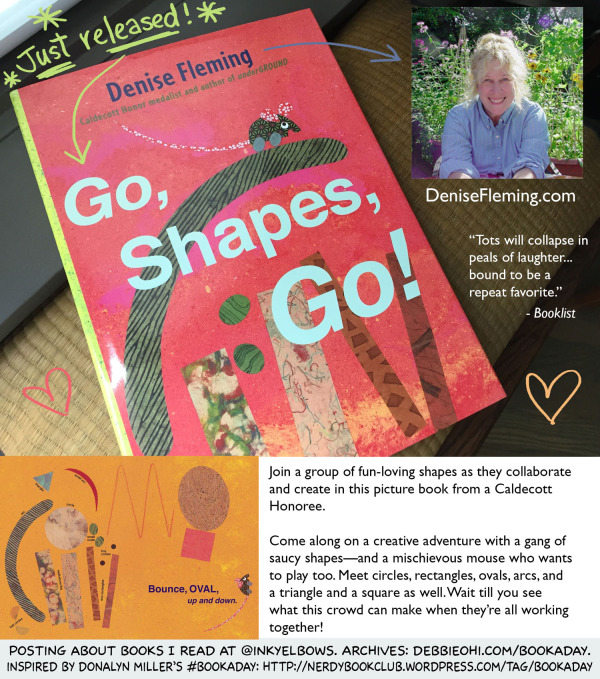
I just bought GO, SHAPES, GO!, a gorgeously illustrated early concept book with such a *fun* story, and it launched TODAY. I've been a fan of Denise Fleming's work ever since I saw Denise demonstrate her pulp painting process at the SCBWI Illustrator Intensives a few years ago.
You can find out more about Denise and her wonderful picture books at: Denisefleming.com (she also offers free READ posters for download!)
More about GO, SHAPES, GO! (including review excerpts) on the Simon & Schuster website.
In my career, I’ve worked a lot with rhyming picture book texts. Not on my agenting list, unfortunately, since the market for rhyming picture books was (and remains) tough. Of my dozen or so picture book author clients, most were author-illustrators who could bring a unique art voice and sense of balance between text and image, the rest were prose picture book writers, and only one worked exclusively in rhyme. Tough odds. The rhyming one did get a book deal during our work together (the absolutely charming GOODNIGHT, ARK by Laura Sassi, illustrated by Jane Chapman), but I heard over and over again from editors that rhyming was tough.
Well, let’s leave rhyming out of it and talk about rhyming’s black sheep sister for a minute: rhythm. If you want to write rhyming picture books, I would actually argue that rhythm, not rhyme, is king of the genre. Most people get so caught up in finding the right rhyme that their rhythm is all over the place and completely sinks the manuscript, almost before it gets started. Are you writing in rhyme and failing to count your syllables? Disaster lies in that direction.
The biggest mistake people writing rhyming PBs make is letting rhyme dictate story. Why does the dog have fleas? Because it has to eat cheese in order for the rhyme to work? Wrong. You’ve written yourself into a prison and you’re going to keep sacrificing the integrity of the story just to hit your rhymes. That’s not great.
The second biggest mistake, as you might be able to guess, is not paying attention to rhythm. If you aren’t yet familiar with syllable counts, iambs, trochees, and all the other trappings of verse, it may be worth your while to get a high school or college poetry textbook. That’s right. A textbook. Because there is stuff to learn about rhythm that was so intricate that you quicky repressed it in the 9th grade. People have been hammering away at poetry for centuries and centuries. Give their hard work at least a cursory nod and study the poetic form before you throw your hat in the ring.
You could have the most beautiful rhyme in the world but if the read-aloud factor isn’t there, and it’s pitted like a road after winter, with starts and stops, your rhyming picture book will go flat. And if you aren’t reading your work aloud as you compose or edit, especially for rhyming picture books, what, exactly, are you doing?! That is absolutely essential, because how it sounds in your head probably isn’t how it sounds out in the air.
Ideally you compose for content (story) and cadence (rhythm). Those two come first and foremost. Only when you master rhythm can you even think about incorporating rhyme.

By: Michelina Ouellette,
on 7/29/2014
Blog:
Michelle Can Draw
(
Login to Add to MyJacketFlap)
JacketFlap tags:
children,
Illustration,
Picture book,
childrens book,
cute,
santa,
christmas,
book illustration,
Picturebook,
children's book,
reindeer,
book launch,
earth friendly,
snt,
childrensbookart,
Add a tag
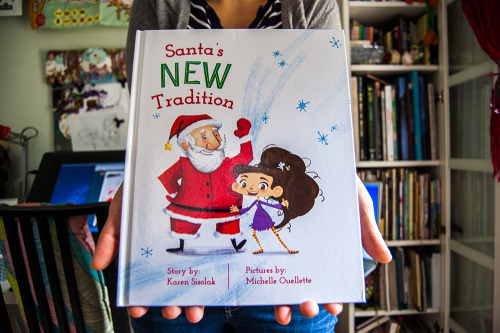

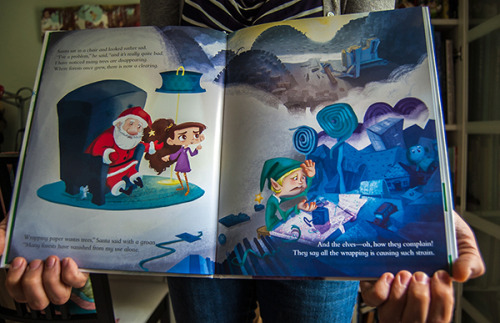

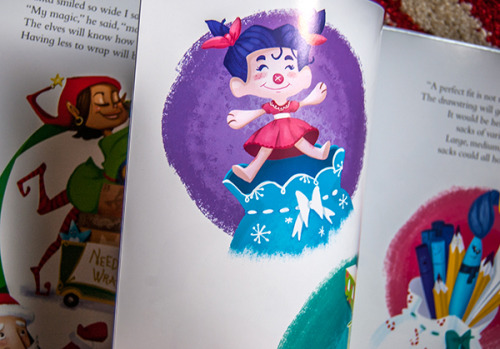
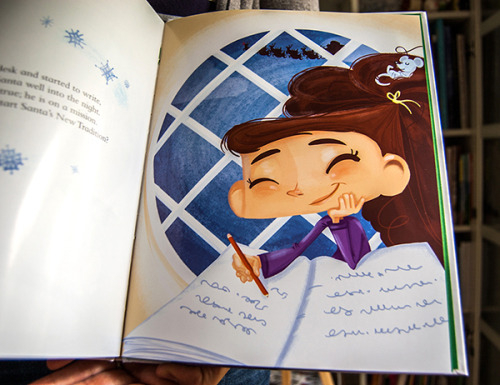
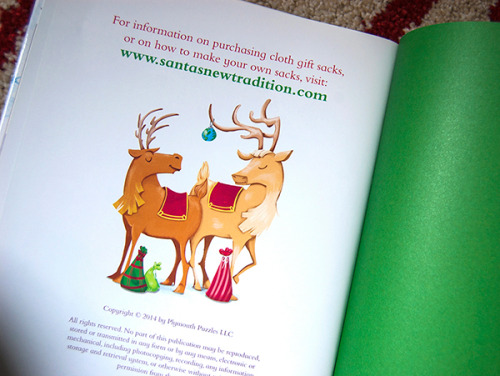
Picturebook Complete: 1,000,000 points!
Super exciting announcement! As some of you might have heard, the picturebook I have been working on from Feb- June has been printed and is (almost!) available for purchase. I just received my hardcopy this weekend, and it is beautiful!
When I was contacted by Plymouth Puzzles about creating a storybook to accompany their upcoming line of Christmas reusable gift bags I was thrilled! The book, Santa’s New Tradition, follows the story of a little girl as she discovers the waste caused by wrapping paper and decides to make a positive change.
I really enjoyed working on this book and am super excited to see it up for sale (looks like late August/ Early September release).
More coming on my process of idea to final later- and thanks for reading!
If you are an illustrator, I highly recommend having a simple portfolio website that you can use to display your work. When you’re querying, instead of attaching images (most editors and agents don’t accept attachments anyway), you can just send a link to your collection. Add new things, change out images in your rotation, and keep it clean, simple, and maintained. That’s about it. And if you’re not tech savvy, you may be able to hire someone via Elance (a freelance marketplace I’ve used to find web designers, or contractors in any arena, in the past) or in your circle of friends to put your image files (scans or digital creations) online. Just make sure that if you use scans, they are of high quality and taken under good lighting that’s true to your intended color scheme.
Two sites that I see a lot of illustrators gravitating to are Wix and SquareSpace. They are built to be user friendly and easy on the wallet. You can use templates provided or get someone to customize your site. These options are modern, work well across multiple platforms, and are easy to link to your other online efforts. I haven’t used either but I’m coming up on a project in my personal life and seriously considering SquareSpace because I like the design and functionality of their sites. I’ve been on WordPress for years and years, so maybe it’s time to try something new, minimal, and graphics-focused!
If all of this is very scary to you, you can just start a free Flickr account and make a gallery of your images. This is the bare minimum, and allows you to host your image and a description (I would opt for one if you can). Send links to the entire gallery in your query so that visitors can click through the whole thing instead of landing on just one image.
Many people overthink this sort of stuff because sometimes computers can be scary and the demands of building a platform seem overwhelming. Don’t let that stop you from putting up a portfolio. Hosting one online has become quite necessary these days, and agents and editors except to see several examples of your work, with different composition, subject matter, tone, palette, etc. (if possible), before they can decide if they’re interested or not.
Most people who start out wanting to write picture books have an idea with a bit of a point to it. It’s usually a lesson about living that they’re eager to pass on to impressionable young minds. Even if that lesson is zany and fun and uplifting, rather than moral or serious in nature, there’s still an element of “Let’s distill some life experience for these young’uns.” Even if it’s not as conscious or overt as all that, teaching is still part of the urge that draws people to writing for the youngest readers.
And there’s definitely a way to act upon these instincts and get across to these impressionable readers. Absolutely! But it’s not to preach or state your “message” aloud. Today’s market, and discerning young readers, don’t much appreciate the, “And then we all learned to share” kumbaya moment at the end of the book where everyone lives happily ever after in peaceful coexistence.
Not only is it a bit Picture Book 101 to tell this kind of moralizing story, but think of your audience. You want to avoid the situation of “wise older character comes and tells younger character all about how life works.” Kids get this all the time from parents, grandparents, teachers, older siblings, pastors, babysitters, etc. They receive a lot of the “should” type of education.
This way of conveying your idea also doesn’t show your child audience the utmost respect. Why? It implies (even if you didn’t mean it to, and many writers don’t!) that the kid doesn’t know all that much about much, and that it takes a wiser (usually older) character to set them straight. This takes all the power away from the kid and gives it to an adult. Again. Just like what happens all over your average 3-7 year-old’s daily life. That’s not as sympathetic to their experience.
They come to stories for maybe another way of getting information. Maybe the “message” is buried in subtext, below the surface. It arises naturally from something the character might experience or realize as they journey through the story you’ve created. I urge every aspiring picture book writer to try and stretch beyond this, maybe to the point where the character realizes some things, or better yet, comes up with the solution to the problem, all by themselves. Through seeing it experienced by a relatable character, kids will interpret your meaning on a deeper and more approachable level.
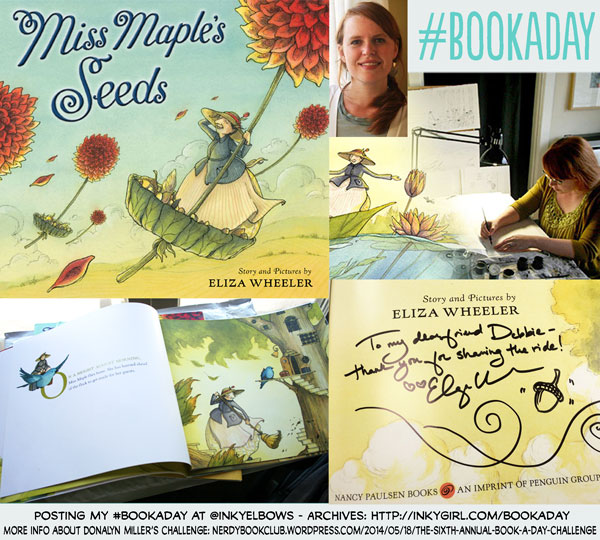
I've fallen a bit behind in my #BookADay posts because of my work schedule, but plan to catch up soon. Perfect for a relaxing Canada Day #BookADay: MISS MAPLE'S SEEDS by my friend Eliza Wheeler (Nancy Paulsen Books/Penguin, 2013). Eliza and I met when we were both picked for the 2010 SCBWI Illustration Mentorship Program, and we've been friends ever since. I'm looking forward to rooming with Eliza next month at the SCBWI-LA convention!
Miss Maple's Seeds has absolutely gorgeous artwork, and such a comforting and inspiring story. My favourite quote: "...Even the grandest of trees once had to grow up from the smallest of seeds."
Synopsis:
"Fans of Miss Rumphius will adore this gorgeous picture book which introduces the kind, nature-loving Miss Maple, who celebrates the miracle in each seed. Miss Maple gathers lost seeds that haven’t yet found a place to sprout. She takes them on field trips to explore places to grow. In her cozy maple tree house, she nurtures them; keeping them safe and warm until it’s time for them to find roots of their own, and grow into the magnificent plants they’re destined to become. Eliza Wheeler’s luminous paintings feature gorgeous landscapes, lush foliage and charming details. Her tender story celebrates the potential found in each seed—since even the grandest tree and most brilliant flower had to grow from the smallest of seeds. Celebrate every season with Miss Maple, from Earth Day to graduations to harvest festivals. "
I interviewed Eliza last year on Inkygirl.com about MISS MAPLE'S SEEDS and her illustrations for Holly Black's DOLL BONES; do check it out for the story of how Eliza and I met, her work process, and advice for aspiring picture book writers and illustrators.
Some of Eliza's excellent advice:
1) Be patient while you build up your body of work. Just focus on your craft, and leave the business side of storytelling for later; for when your work is REALLY good.
2) Create the kind of work that your kid self would have loved. Be your own audience, and always ask yourself "If someone else made this, would I read it? Would I put it up on my wall?". It seems obvious, but more often than not when I ask myself this question, I'm surprised to think "no".
3) Read, read, read. Whenever I'm stuck with my storytelling I read. I get new ideas or answers to existing stories when I read. And don't just read in your genre. A friend lent me Aimee Bender's adult novel The Particular Sadness of Lemon Cake, and I was distracted through the entire thing because every single time I sat down to read that book, a particular story I was working on would come to me in waves. I don't know why that was, but certain books will do that, and I've learned that it's a really great thing.
---------
Find out more about Donalyn Miller's Summer Book-A-Day Challenge on the Nerdy Book Club site, and you can read archives of my #BookADay posts.

Doll spot illustration from a storybook I’m working on!
Coming from Viking Children’s Books, June 13.
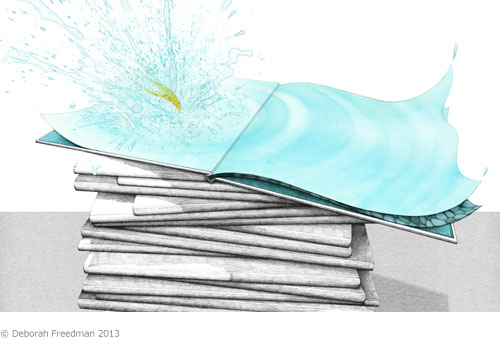
Filed under:
Random Tagged:
fish,
fish & snail,
picturebook,
snail 

The Cats on Ben Yehuda Street
ISBN 10/13: 0761381244 | 9780761381242
Category: Picture book
Keywords: Cats, neighbors, friends, compassion
Format: Hardcover, Paperback, eBook
Source: Finished copy for review
Things are always the same on Ben Yehuda Street--cats, cats, cats everywhere--and boy do they love Mr. Modiano's store, the Tel Aviv Fish Palace! His neighbor, Mrs. Spiegel, loves to knit and spend time with her cat Ketzie. Ketzie shares fish from Mr. Modiano's shop with her friend Gatito. But old Mr. Modiano hates the cats as much as they love his shop. "Lo, lo, lo," he says, always declining Mrs. Spiegel's invitations to tea. All he wants to do is shoo the cats away (who never listen, by the way!) until one day, Ketzie goes missing. Uh oh!
I have to tell you first about how biased I am in reviewing this book. One, I am a cat lover and a knitter like Mrs. Spiegel. I have my own little gray cat (though she has more stripes than Ketzie). Two, I am friends with Ann. I designed
her website and I think she is such a fun storyteller! Three, I love fish, of which there is quite a lot in this book. If I were to hold a storytime event for this I would probably serve kippered herring, lox (smoked salmon), and maybe seared garlic tuna,
mmmmm! Though all but the most discerning little kids would probably prefer this kind of fish instead:
... not real fish
I loved the story and think it would make a great read-aloud for grandparents and grandkids together. I predict lots of meowing and "Lo, lo, lo"ing! Lots of little clues in the illustrations reveal details about everyday life in Israel, so there's a lot to point out and explain, whether one is familiar with the culture or not. The reader might wonder at Mr. Modiano's mode of transportation, what he's wearing on his head (it took me a couple of reads to figure out it wasn't a beret!), and maybe what Mrs. Spiegel is baking. Most importantly, what could have happened to Ketzie?
Themes like friendship, compassion, and generosity make this a gentle bedtime read. But while I like Carabelli's simple and sweet cat illustrations and painterly backgrounds, there's a certain level of detail I felt was missing. Maybe it's the knitter in me, always trying to spot drawings of yarn and knitted objects, but aside from a couple of balls of yarn, I couldn't really believe Mrs. Spiegel was much of a knitter, and that was a bit disappointing. The colors are also very muted and almost muddy for the most part. But I do like the little fish all over Mr. Modiano's shirt!
Ann is giving away a copy of The Cats of Ben Yehuda and her picture book from last year, The Wooden Sword! To enter, just comment below and answer:
What is your favorite folktale?
This giveaway is open internationally!
We hope you'll join us for the rest of the blog tour as well.
a Rafflecopter giveaway

By: Molly,
on 9/20/2012
Blog:
the pageturn
(
Login to Add to MyJacketFlap)
JacketFlap tags:
Books,
Picture Books,
Videos,
Beginning Readers,
picturebook,
YA Books,
Booktalks,
Tween books,
yalit,
pageturnpicks,
Add a tag
We’ve teamed up with our brilliant Online Gurus here at HarperCollins Children’s Books to bring you something new on The Pageturn: monthly videos highlighting that month’s “picks,” featuring picture books, chapter books, middle grade and YA.
They’ll be brief booktalks of titles that we feel are perfect for your use in libraries and schools, both brand new and old favorites, directly from our hearts to yours. We don’t think we’ll be ever be YouTube stars (just wait for the blooper reel!), but our goal was to replicate as much as possible that great experience we have at conferences with you all, talking face to face, sharing what we love.
So here we go! Thoughts? Suggestions? We want to hear!
Molly’s September picks:
Picture Books:
EVERYTHING GOES: IN THE AIR, by Brian Biggs
GOLDILOCKS AND THE THREE DINOSAURS, by Mo Willems
Chapter Books:
FANCY NANCY: NANCY CLANCY, SUPER SLEUTH, by Jane O’Connor, Illustrated by Robin Preiss Glasser
Middle Grade:
THE PECULIAR, by Stefan Bachman
THE GREAT UNEXPECTED, by Sharon Creech
Teen:
THE CROWN OF EMBERS, by Rae Carson
Dan Krall's 3rd book and first author credit,
Absolutely Beastly Children (Tricycle Press) hits the shelves. A delightful rhyming ABC book featuring ink and (digital) watercolor illustrations of 26 horrible little brats.
In this book you’ll find 26 children who are almost certainly nothing like you. You always eat your peas and say please. You, unlike Oscar, would never tell lies. And in your wildest dreams you wouldn’t play with your food the way Nancy does. But even the sweetest child can be tempted to behave badly. Thankfully, Dan Krall has put together this collection to remind us just how unpleasant beastly behavior can be.
Buy the book...Dan Krall is an Art Director and Development Artist for Animated Television and Film. Credits include,
Coraline, Scooby Doo Mystery Incorporated, Samurai Jack, The PowerPuff Girls and
Dexter's Laboratory. See his portfolio and other books on his website at:
dankrall.com.
 Got my latest copy of Picturebook 10 recently. Just what I needed- a little bit of inspiration and see what my fellow children's illustrators are up to.
Got my latest copy of Picturebook 10 recently. Just what I needed- a little bit of inspiration and see what my fellow children's illustrators are up to.
 And here is my piece!
And here is my piece!
By:
jrpoulter,
on 5/20/2009
Blog:
Jrpoulter's Weblog
(
Login to Add to MyJacketFlap)
JacketFlap tags:
Dirk Walbrecker,
children,
children's books,
books,
illustration,
music,
Reading,
humour,
Fiction,
Pets,
picture books,
Cats,
Writing,
inspiration,
children's literature,
Animals,
picturebook,
jazz,
children's stories,
CD,
concert,
performance,
imagery,
story books,
Bernhard Oberdieck,
Family pet,
creative arts,
cross cultural exchange,
Add a tag

Cat's Concert -1
Dirk Walbrecker and Bernhard Oberdieck
“Katzenkonzert”, The story of Bianca and Nero
How sad life can be if there is no one to play with! This is the fate of an old piano which is all alone in a cellar bar. Longingly, it remembers the days when the pianist Tom coaxed beautiful sounds out of it. But who appears in the cellar instead of Tom and starts to produce totally new sounds? First Nero, the amorous black tomcat with the white paws! Then Grrr, the amorous grey tomcat with the grim face! And finally Bianca, the elegant cute white cat with the black paws … A concerto for cats in major and minor modes, on black and white keys, with black, grey and white paws. And who plays best with whom in the end? The text and music of Katzenkonzert can be listened to on the accompanying CD – spoken by Dirk Walbrecker with jazzy classical improvisations by Jenö Nyári. Dirk Walbrecker studied German language and literature and educational science, among others. Since 1986 free-lance author: screenplays, radio plays, picture books, novels for children and young people. Many reading tours. For further information, see web site at www.dirkwalbrecker.de.
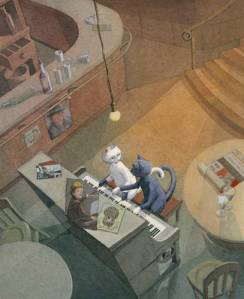
Cat's Concert - 2
Bernhard Oberdieck sat at the desk of his father at the age of four already, decorating the back sides of business letters. Studied graphic design in Bielefeld, worked as art teacher and in advertising agencies. Since 1978 free-lance illustrator of more than 180 books for national and international publishers. For further information, see web site at www.kinderbuchillustration.com. When Cats are jazzing … A musical story for young and old cat lovers A concerto with black and white paws
Including CD
Target group: Children aged 6+, parents
32 pages (with CD) fully illustrated in four colours
hardbound 21,8 x 27,5 cm
ISBN: 3-7957-0186-4 (ED 20433) € 19,95
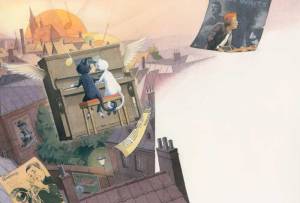
Cat's Concert -3

Cat's Concert-4






.jpg?picon=380)
By:
[email protected] (Mark Blevis and Andrea ,
on 5/5/2009
Blog:
Just One More Book Children's Book Podcast
(
Login to Add to MyJacketFlap)
JacketFlap tags:
kitlit,
Paul Jacobs,
reading,
poet,
Writing,
Author,
Podcast,
Interviews,
books,
Creativity,
literacy,
picturebook,
documentary,
childrens-books,
Special Series,
justonemorebook,
Rock Stars of Reading,
kidlit,
rockstarsofreading,
Add a tag
Listen in as Mark and Author/Poet, Paul Jacobs, chat about the differences between children and adults as book and reading audiences, writing with a playful spirit and the collaborative nature of children’s books.
Books you may have seen by Paul Jacobs…



MUSIC

.jpg?picon=380)
By:
[email protected] (Mark Blevis and Andrea ,
on 5/4/2009
Blog:
Just One More Book Children's Book Podcast
(
Login to Add to MyJacketFlap)
JacketFlap tags:
Writing,
picturebook,
documentary,
childrens-books,
Special Series,
justonemorebook,
Rock Stars of Reading,
Leslea Newman,
kitlit,
Author,
Podcast,
Interviews,
books,
reading,
Creativity,
literacy,
Add a tag

Author/poet Lesléa Newman, author of the groundbreaking book Heather Has Two Mommies, talks to Mark about seeing in words (not images), writing for adults and children, and treasures in our brains.
MUSIC
Book by Lesléa Newman you may have seen…
.jpg?picon=380)
By:
[email protected] (Mark Blevis and Andrea ,
on 4/26/2009
Blog:
Just One More Book Children's Book Podcast
(
Login to Add to MyJacketFlap)
JacketFlap tags:
books,
illustration,
reading,
Creativity,
literacy,
Video,
picturebook,
documentary,
Special Series,
justonemorebook,
childrensbooks,
Rock Stars of Reading,
kitlit,
jeffmack,
rockstarsofreading,
Add a tag
Click here to view the embedded video.
Take note of the name Jeff Mack. He’s a relative newcomer to children’s books and has a very bright future. His stories are endearing and his illustrations inviting. We had the chance to see him in action and better understand his creative process as he coached Lucy and Bayla through sketching, mixing paint and painting their own illustration.



MUSIC
.jpg?picon=380)
By:
[email protected] (Mark Blevis and Andrea ,
on 4/22/2009
Blog:
Just One More Book Children's Book Podcast
(
Login to Add to MyJacketFlap)
JacketFlap tags:
books,
illustration,
reading,
Creativity,
literacy,
Video,
picturebook,
documentary,
Special Series,
justonemorebook,
childrensbooks,
Rock Stars of Reading,
kitlit,
jeffmack,
rockstarsofreading,
Add a tag
Click here to view the embedded video.
Perhaps more intriguing than books themselves is the story behind them; how they were conceived, how they were picked up by a publishing company and how they were edited. Author/illustrator Jeff Mack has many incredible stories to tell from his young career and he took the time to share many of the stories and explain his creative process to us.
We particularly enjoyed how he engaged with Lucy and Bayla and how they may have had an influence on a creative decision for his upcoming book, Dog Wants to Play, due out September 3, 2009 (author: Christine McDonnell).



MUSIC

By:
Donna J. Shepherd,
on 11/26/2007
Blog:
Topsy Turvy Land - Donna J. Shepherd
(
Login to Add to MyJacketFlap)
JacketFlap tags:
Kevin Scott Collier,
Donna Shepherd,
Hidden Pictures,
Hidden Picture,
Liz Ball,
Picturebook,
Topsy Turvy Land holiday,
Picture Book,
poetry,
Christmas,
Children's,
Donna Shepherd,
Kevin Scott Collier,
Topsy Turvy Land,
Hidden Picture,
Liz Ball,
Picturebook,
Hidden Pictures,
Topsy Turvy Land holiday,
Topsy Turvy Land holiday,
Add a tag
Check your Christmas list. Do you have children to buy for? May I suggest a copy of Topsy Turvy Land? Here are a few of the stores with Topsy Turvy Land in stock. You can also order the book from almost any bookstore (presently through Baker & Taylor, Inc. and/or Partners Book Distributing, Inc.), or order directly from the publisher! Click here!
Online Stores:
Hidden Pictures Publishing
Amazon
.jpg?picon=380)
By:
Just One More Book!!,
on 10/25/2007
Blog:
Just One More Book Children's Book Podcast
(
Login to Add to MyJacketFlap)
JacketFlap tags:
Ages 4-8,
Detailed,
Creativity,
Forgiveness,
Respect,
Picture book,
Girl,
Resilience,
Fun,
Adventure,
Cartoony,
Hilarious,
Humour,
Visual,
Rhyming,
Assertiveness,
Confidence,
Perseverence,
Arts,
Understanding/Tolerance,
review,
Podcast,
Community,
Contributing,
Appreciation,
childrens book,
Life Skills,
Freedom,
Cute,
acceptance,
Thinking/Attitude,
Andrea Beaty,
Fairness / Justice,
David Roberts,
Architect,
Iggy Peck,
Add a tag
 Author: Andrea Beaty (on JOMB)
Author: Andrea Beaty (on JOMB)
Illustrator: David Roberts (on JOMB)
Published: 2007 Abrams Books for Young Readers (on JOMB)
ISBN: 081091106X Chapters.ca Amazon.com
Uncommonly crisp, comical illustrations combine with flippant, rhyming text to chronicle the irrepressible ingenuity of an audacious seven year old — and to remind us to make space for what makes people tick.
Other books mentioned:
Tags:
Andrea Beaty,
Architect,
childrens book,
David Roberts,
Iggy Peck,
Podcast,
reviewAndrea Beaty,
Architect,
childrens book,
David Roberts,
Iggy Peck,
Podcast,
review

By:
Donna J. Shepherd,
on 9/21/2007
Blog:
Topsy Turvy Land - Donna J. Shepherd
(
Login to Add to MyJacketFlap)
JacketFlap tags:
Kevin Scott Collier,
Donna Shepherd,
Picturebook,
eBook,
Guardian Angel Publishing,
Skincare,
Sunburn,
dermatology,
dermatologist,
Picture Book,
Children's,
skin,
Guardian Angel Publishing,
Donna Shepherd,
Kevin Scott Collier,
eBook,
Sunburn,
Skincare,
dermatologist,
dermatology,
Picturebook,
Add a tag
Kevin sent an email first thing this morning with news of a review for Ouch! Sunburn! What a nice surprise! Check it out - TCM Reviews.
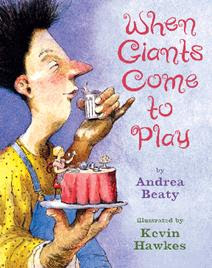 Andrea Beaty on Andrea Beaty: "I come from a very big family and a very small town in southern Illinois. There weren't a lot of thrilling things to do in town, so we had to make our own fun. We roamed the fields and woods looking for adventures and we made up sports. Our favorites were chasing each other around the yard with old tires and trying to make each other laugh until we begged for mercy. Of course we were easy tire targets because we kept falling over laughing. It's hard to say if we looked more like a bad Monty Python sketch or narcoleptic goats.
Andrea Beaty on Andrea Beaty: "I come from a very big family and a very small town in southern Illinois. There weren't a lot of thrilling things to do in town, so we had to make our own fun. We roamed the fields and woods looking for adventures and we made up sports. Our favorites were chasing each other around the yard with old tires and trying to make each other laugh until we begged for mercy. Of course we were easy tire targets because we kept falling over laughing. It's hard to say if we looked more like a bad Monty Python sketch or narcoleptic goats.
"Our mother was a voracious reader and filled our house with books so when I wasn't on an adventure or blowing soda out my nose from laughing too hard, I was reading. I had about a hundred things I was going to be when I grew up: spy, detective, arctic explorer, interpreter for the U.N., pirate, English veterinarian, head of the CIA, pool shark...
"I think the great thing about being a writer is that I can still be all of those things if I just keep writing! I guess I've already been a giant, an architect, and a bear doctor! What's next?"
What about the writing life first called to you?
It was probably the voices.
What made you decide to write for young readers?
It wasn't really a conscious decision. In my late 30s, random ideas and snippets of stories started popping into my head when I was gardening, taking a walk, or picking lint off my children. These ideas were all about giants, pirates, and slugs. A lot of them were in rhyme.
I started playing with the ideas and writing them down and they turned out to be kids' books and poems.
Maybe I would write for adults if they read more books about giants or slugs or pirates. Adult books can be so dull!
Perhaps someday that market will open up and I will at last write the Great American Novel in which GIANT SLUG PIRATES RULE THE UNIVERSE!!!! Bwa-ha-ha-ha!
(See what I mean by "the voices?")
Could you tell us about your path to publication, any sprints or stumbles along the way?
Syncopated is the word that comes to mind when I describe this journey. I started submitting stories to publishers about a year after I started writing. During the next three years, I had flurries of activity--getting some interest from editors, finding a literary agent and winning a Society of Children's Book Writers and Illustrators grant for When Giants Come to Play, illustrated by Kevin Hawkes (Abrams, 2006).
These exciting times were always followed by long, slow periods when it seemed nothing would ever happen again. Even after I sold my first two books (at one time!), it was about three years before I sold more books. That was a bit hard, because I had bizarre delusions that once I sold my first book, the rest would be a cakewalk. Of course, that was nonsense and I knew it, but it was easy to think I'd be the exception to that rule!
I learned that the only way to stay sane during the lulls was to keep writing and not to get bent about the rest of the process. Of course, that was easier said than done.
It helped when I quit stalking the mailman to see if he had any book contracts for me. I used to love the way he said things like, "If by 'contract,' you mean 'restraining order' then yes!" and "Two-hundred yards is two-hundred yards, lady!"
Sometimes I miss those days, but in the end, I realized that the best way to use my energy was to write. Getting published is a fantastic, fun, and thrilling joy ride for me, and I'd be a liar if I said it wasn't. But as sappy as it sounds, it's really the deep satisfaction of writing that makes this journey the most exciting. Getting a new idea and being sucked into other worlds and stories is just plain magical.
Plus, I believe that when writing stops being magical, I won't write anything worth publishing anyhow! I try to spend my energy on the writing and figure the publishing part will follow. So far, I've been lucky and it has.
Your debut title is When Giants Come to Play, illustrated by Kevin Hawkes (Abrams, 2006). Congratulations! What was your initial inspiration for writing this book?
Many of my books start when a word or phrase gets stuck in my mind. There are a lot of cobwebs in there so it can happen pretty easily. In this case, the word "giants" got stuck in my brain and rattled around for a bit. It grew into the phrase, "When giants come to play." That was an idea with potential.
I went to bed and literally woke up in the middle of the night with the complete book in my head. I wrote it down and polished it up the next day and sent it off to the Society of Children's Book Writers and Illustrators grant competition for unpublished writers. I was thrilled a few months later when it won the runner-up Barbara Karlin grant!
Writing When Giants Come to Play was a turning point for me. After I wrote it, I felt tingly for a week. I loved this book and felt that I had found my voice when I wrote it. Before Giants, I thought of myself as a person who wrote. After Giants, I thought of myself as a writer.
What were the challenges (literary, research, psychological, logistical) in bringing it to life?
I have to say that this was a strange book in that sense. It happened VERY fast and didn't involve a lot of emotional or psychological challenges.
This book hit me like a lightening bolt and was mostly complete in its first draft. And yet, it didn't sell to the very first editor who saw it! Or even the second! What was that about?????
About a year after I wrote When Giants Come to Play, I started working with a wonderful literary agent named Barry Goldblatt (agent interview). He read the book and said that it needed a story arc. A what???? How could my perfect book need work????
Of course, Barry was right, and after I added a new beginning and end to the story, it was so much better than the first draft. This sold to Susan VanMetre who was at Dutton but shortly after left for Abrams Books for Young Readers. I had met Susan at a conference and wanted to work with her, so we took Giants to Abrams, too. Susan signed on Kevin Hawkes to illustrate the book, which was simply beyond thrilling!
What did Kevin's art bring to your text?
Kevin's art captured the soul of these giants! He captured the whimsy and wonder of the text and played the jokes to the perfect pitch. He gave them the perfect balance between rough and gentle. Kevin's giants are a bit gruff but, at the same time, a bit childlike. They are devoted to the little girl, Anna, and treat her so tenderly.
Much of the humor of the book was written into the original manuscript via art notes, but Kevin took those ideas and ran with them even further. In some of the scenes he went entirely in new directions I hadn't considered. It was thrilling!
Kevin Hawkes is a wonder!
You have another picture book and a novel coming from Abrams and five picture books coming from Atheneum Books for Young Readers! Wahoo! It looks like you already have a hearty body of work in the queue. Please tell us how you smashed the odds in a tough picture book market!
I really and truly do not know. The only explanation I have is luck, timing, and a great agent! (And of course, I eat my Wheaties!) I have been extremely blessed in being able to sell some books in a tough market, but I don't take it for granted. Getting published seems to be a feast and famine adventure. I know that while I'm on a roll now, I might not be next year. I try to take it as it comes. (And eat my Wheaties!)
What advice do you have for beginning writers?
When you get an idea, write it down. It sounds obvious, but you'd be surprised how fleeting good ideas are. I know this because last year, I had the idea for the Great American Novel. Alas, I forgot to write it down, and now I can't remember what it was! I think it had something to do with giant pirate slugs.
Write for yourself. Don't try to please someone else when you write. It won't work. It's never possible to predict what trends will come down the road. Don't waste your time trying.
Not every piece of advice you get will be useful. (That probably includes some and/or all of this advice!) Always think critically about input you get on your writing. If it doesn't ring true to you, ignore it! Not everybody is going to get what you do. Most probably won't! The important thing is that YOU get it!
Join the Society of Children's Book Writers and Illustrators if you want to write for kids. It's a great place to make contacts and find folks who have gone down the path before you. It's also a great place to meet folks who are at the same point in the journey as you. Both are extremely valuable! Plus, kids' writers are just plain fun! Get to know some!!!
Eat your Wheaties!
How about picture book writers in particular?
Oh boy! I'm full of advice on this topic! But before following my advice, readers should remember my earlier point. Advice should always be taken a grain of salt. Each writer has to listen to their inner voice and learn to trust themselves--even when it means discarding tried and true rules or advice from folks like me.
Having said that, this is the advice I offer to picture book writers.
-- Let the art do the heavy lifting. Don't add unnecessary descriptions in the text when they could be and should be handled by the artist. Sometimes that means including art notes, but use them only when you must. For example, an art note is important when some action takes place in the art but not in the text. Art notes are annoying and a bad idea when used to say what color the slug's shirt should be or what the weather is like unless it is vital to the plot. Before including an art note (or text in your story for that matter), ask yourself if it furthers the action of the story. If it doesn't, pitch it.
-- Picture books are, in my opinion, a form of poetry. Each and every word has to belong, make sense, and add to the sound of the book. If a word or phrase doesn't do that, cut it out.
-- I prefer short picture books. Any text that runs over 750 words needs a very good reason to do so. Most don't have one. There are many fine longer books, but if they work, it's because they NEEDED to be longer.
-- NEVER write a book in rhyme unless the book demands it. Writing rhyming books is more a function of music than poetry. (IMHO!) I think most people either have a natural facility with rhyme or they don't. If you don't have that, don't sweat it. Stick with prose, and you'll be ahead of the game.
-- If you do write in rhyme, always strive to use the unexpected word instead of the easy/obvious choice. Read authors like Lisa Wheeler who are masters of rhyme. Sailor Moo is a rhyming masterpiece. [ See Sailor Moo, Cow at Sea by Lisa Wheeler, illustrated by Ponder Goembel, Atheneum, 2002 (author interview).]
-- Write out loud. Picture books are almost always intended as books that are read aloud. It is ESSENTIAL that you read your book out loud so you can tell how it sounds. In fact, I write out loud. It is almost impossible for me to write a word without saying it aloud at the same time. This helps me internalize the rhythm of the book and has the added benefit of making people think I'm nuts. They tend to leave me alone and I can get more writing done! It's a win-win situation!
-- Never write a book with the intention of making a point. Kids and editors can smell that a mile away and will run off screaming!
-- Eat your Wheaties!
You are one of the three geniuses behind one of my fave blogs, Three Silly Chicks! Could you share with us the story behind this fabulous team effort?
Geniuses? Actually, we prefer to be called Mad Chick Geniuses Who Plan to Take over the World. (Just saying . . .)
Boy, how I love the Three Silly Chicks! www.ThreeSillyChicks.com
It's a blog from me and two of my favorite children's authors who write funny books: Carolyn Crimi (author interview) and Julia Durango (author interview). We review funny picture books and novels for kids. Sometimes we have silly contests and we love to interview our favorite funny authors.
And we have a cool logo!
Our hope is that Three Silly Chicks will be a good resource for anybody looking for funny kids' books. That could mean teachers, librarians, parents, chickens or even giant pirate slugs! Everybody loves funny books! (At least everybody we like!)
The Chicks happened because we all have the same agent who holds a retreat every year for his authors. We get together and talk and laugh and learn from each other for a long weekend. It's brilliant! At last summer's retreat, there was a conversation about blogs. Someone said that a great way to do a blog is with someone who has similar interests.
Zap!!!
I looked at Carolyn. She looked at me! We had a blog! Julia came by a few minutes later and she was in, too! It was fantastic.
It's fun because we all have our own flavors of humor and we learn about funny new books from each other.
And sometimes when we're feeling lazy, we just spend the whole afternoon in the coop wearing funny glasses and doing the Chicken Dance. I love it!
What do you do when you're not writing?
The Chicken Dance, of course!
What can your fans look forward to next?
I am tickled to say that I have a number of books on the way.
Iggy Peck, Architect
Illustrated by David Roberts
Abrams Books for Young Readers
ISBN: 978-0810911062
August 2007
Iggy is a kid who is passionate about architecture. He builds from anything in his reach, including pancakes, chalk or even dirty diapers! Things get complicated for Iggy when his 2nd grade teacher turns out to hate architecture almost as much as he loves it.
Doctor Ted
Illustrated by Pascal LeMaitre
Atheneum Books for Young Readers
ISBN: 1416928200
Spring 2008
When a bear named Ted wakes up one morning and bumps his knee. He looks for a doctor everywhere. When Ted can't find a doctor, Ted becomes a doctor. Ted is a great doctor and can diagnose almost any condition on the spot. Alas, Ted's talent lands him in trouble at school.
Cicada Summer
Novel (ages 9-12)
Abrams Books for Young Readers
2008
Who is the strange new girl in Olena? The girl with the odd scar and a secret? Only Lily notices that this strange girl steals from Fern's store and lies. Only Lily knows this girl means trouble. Lily Mathis is the only one who knows. Lily could tell, but she won't. She never tells anybody anything... ...not since Pete.
Firefighter Ted
Illustrated by Pascal LeMaitre
Atheneum Books for Young Readers
Spring 2009
Ted returns to save the day as a firefighter.
Hush, Baby Ghostling
Illustrated by Pascal LeMaitre
Atheneum Books for Young Readers
Summer 2009
A tender, humorous rhyming picture book tells of a mother ghost trying (not very successfully) to get her baby ghostling to sleep.
Master Ted, True Artiste
Illustrated by Pascal Le Maitre
Atheneum Books for Young Readers
2010
Ted returns, with paintbrush in hand, as a master artiste!

























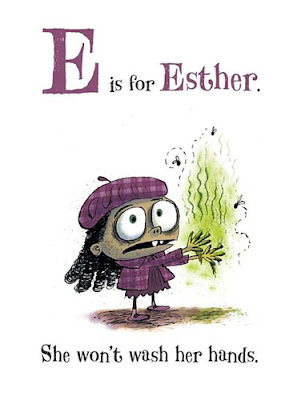
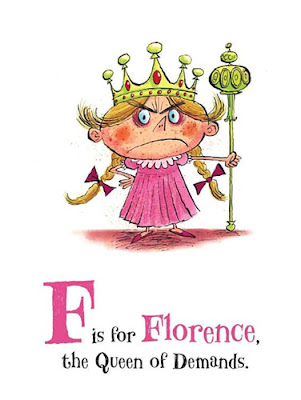




















 Author:
Author: 
Babe the Blue Ox =)